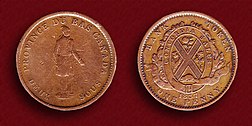Canadian pound
| Canadian pound | |
|---|---|
| Canadian pound (Canadian English) | |

1 penny (2 sous) bank token (1837)
|
|
| Denominations | |
| Subunit | |
| 1⁄20 | shilling |
| 1⁄240 | penny |
| 1⁄480 | sou |
| Plural | pounds |
| shilling | shillings |
| penny | pence |
| sou | sous |
| Symbol | £ |
| shilling | s |
| penny | d |
| Demographics | |
| Date of introduction | 1841 |
| Date of withdrawal | 1858 |
| Replaced by | Canadian dollar |
| User(s) |
|
| Valuation | |
| Value | £1 = $4 |
|
This infobox shows the latest status before this currency was rendered obsolete.
|
|
The pound (symbol £ or C£) was the unit of account for currency of the Canadas until 1858. It was subdivided into 20 shillings (s), each of 12 pence (d). In Lower Canada, the sou was used, worth 1⁄2 penny. Although the pounds, shillings, and pence accounting system had its origins in the British pound sterling, the Canadian pound was never linked to British currency.
In North America, the scarcity of British coins led to the widespread use of Spanish dollars. These Spanish dollars were accommodated into a pounds, shillings, and pence (£sd) accounts system, by setting a valuation for these coins in terms of a pound unit. At one stage, two such units were in widespread use in the British North American colonies. The Halifax rating dominated, and it set the Spanish dollar equal to 5 shillings. As this was 6 pence more than its value in silver, the Halifax pound was consequently lower in value than the pound sterling which was actually the original basis for the pounds, shillings, and pence accounting system. The York rating of 1 Spanish dollar equal to 8 shillings was used in Upper Canada, officially until its outlawing in 1796, but unofficially well into the 19th century.
In 1825, an Imperial order-in-council was introduced for the purposes of causing sterling-specie coinage to circulate in the colonies. The idea was that this order-in-council would make the sterling coins legal tender at the exchange rate of 4s 4d per Spanish dollar. This rate was in fact unrealistic and it had the adverse effect of actually driving out what little sterling-specie coinage was already circulating. Remedial legislation was introduced in 1838 but it was not applied to the British North American colonies due to recent minor rebellions in Upper and Lower Canada.
In 1841, the Province of Canada adopted a new system based on the Halifax rating. The new Canadian pound was equal to 4 U.S. dollars (92.88 grains gold), making one pound sterling equal to £1 4s 4d Canadian. Thus, the new Canadian pound was worth 16s 5.3d sterling. The earliest Canadian postage stamps were denominated in this Halifax unit.
...
Wikipedia
